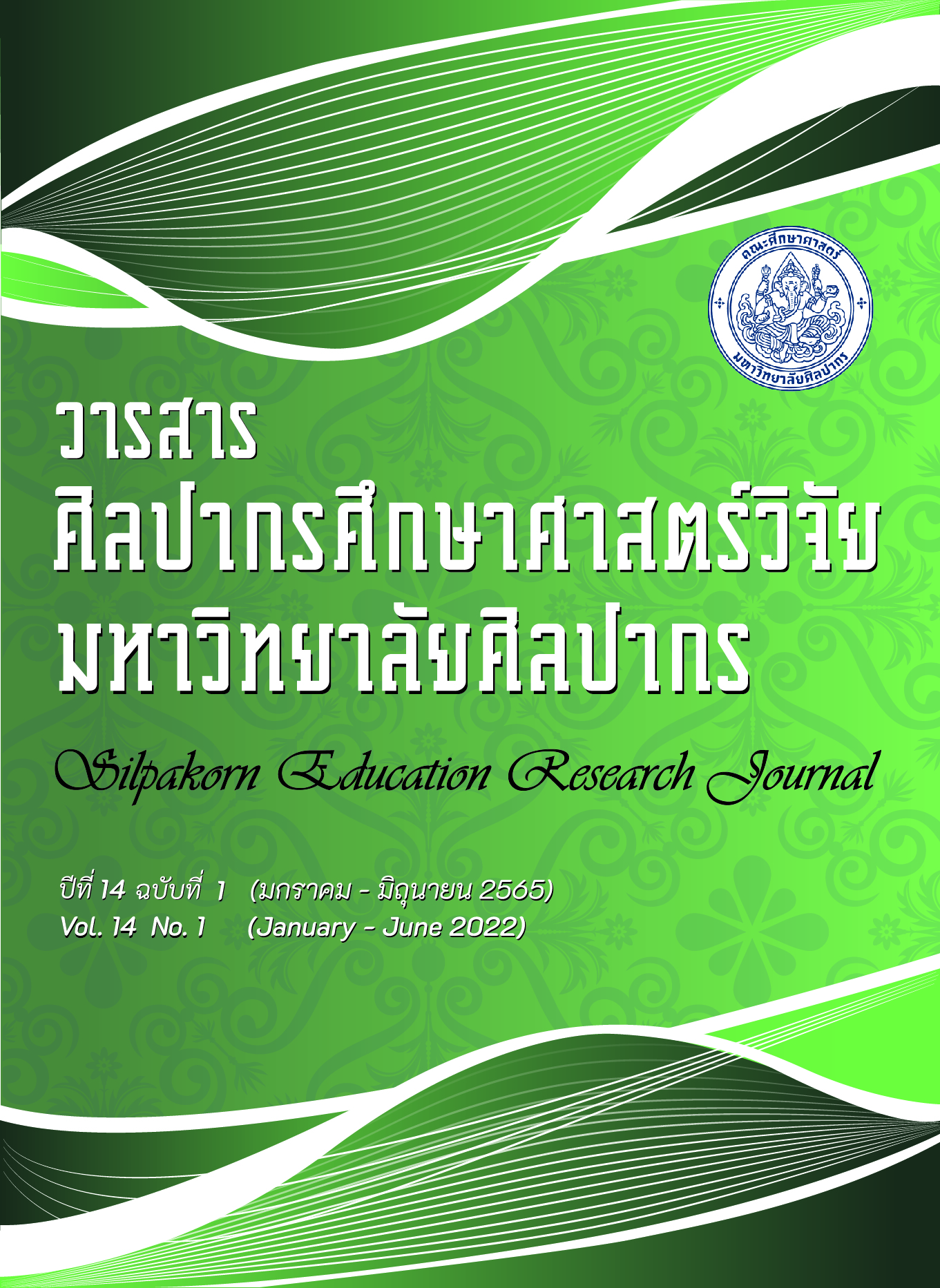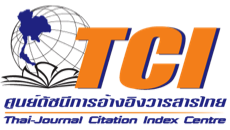การใช้รูปแบบการเรียนรู้ที่เน้นประสบการณ์เพื่อปรับเปลี่ยนมุมมอง เพื่อส่งเสริมการเรียนรู้ เรื่อง แสงและการมองเห็น ของนักเรียนชั้นมัธยมศึกษาปีที่ 2
คำสำคัญ:
ประสบการณ์เพื่อการปรับเปลี่ยนมุมมอง/ แสงและการมองเห็น/ แนวคิดวิทยาศาสตร์บทคัดย่อ
งานวิจัยครั้งนี้มุ่งใช้รูปแบบการเรียนรู้ที่เน้นประสบการณ์เพื่อปรับเปลี่ยนมุมมอง เพื่อส่งเสริมการเรียนรู้ เรื่อง แสงและการมองเห็น ของนักเรียนชั้นมัธยมศึกษาปีที่ 2 โดยกำหนดจุดประสงค์การวิจัยดังนี้ 1) เพื่อเปรียบเทียบความเข้าใจแนวคิดวิทยาศาสตร์ เรื่อง แสงและการมองเห็น ของนักเรียนชั้นมัธยมศึกษาปีที่ 2 ก่อนและหลังการเรียนรู้ที่เน้นการจัดประสบการณ์เพื่อการปรับเปลี่ยนมุมมอง และ 2) เพื่อศึกษาการตอบสนองต่อประสบการณ์เพื่อการปรับเปลี่ยนมุมมอง เรื่อง แสงและการมองเห็น ของนักเรียนชั้นมัธยมศึกษาปีที่ 2 ระเบียบ วิธีวิจัยเน้นการวิจัยเชิงกึ่งทดลอง โดยผู้เข้าร่วมวิจัยครั้งนี้เป็นนักเรียนชั้นมัธยมศึกษาปีที่ 2 จำนวน 40 คน และรวบรวมข้อมูลการวิจัยด้วยการใช้แบบวัดความเข้าใจแนวคิดและแบบสำรวจประสบการณ์เพื่อการปรับเปลี่ยนมุมมอง เรื่อง แสงและการมองเห็น ของนักเรียนชั้นมัธยมศึกษาปีที่ 2 ก่อนและหลังการจัดการเรียนรู้ รวมถึงการรวบรวม การวิเคราะห์ผลงานและเอกสารการเรียน ผลการวิจัยพบว่า นักเรียนมีความเข้าใจแนวคิดวิทยาศาสตร์ เรื่อง แสงและการมองเห็น หลังเรียนสูงกว่าก่อนเรียนอย่างมีนัยสำคัญทางสถิติที่ระดับ .01 และนักเรียนมีการตอบสนองต่อประสบการณ์เพื่อปรับเปลี่ยนมุมมอง เรื่อง แสงและการมองเห็น ในด้านความสามารถนำแนวคิดวิทยาศาสตร์มาใช้ในสถานการณ์ต่าง ๆ ด้านความเข้าใจและตระหนักในสิ่งที่ได้เรียนรู้ และด้านการตระหนักถึงคุณค่าในสิ่งที่ได้เรียนรู้อยู่ในระดับสูงถึงสูงมาก นอกจากนี้นักเรียนส่วนใหญ่สะท้อนว่า การเรียนการสอนที่เน้นการจัดประสบการณ์เพื่อการปรับเปลี่ยนมุมมองช่วยให้สนุกกับการเรียนมากขึ้น
เอกสารอ้างอิง
Panusi, K. (2010). Alternative Concepts on Light and Image Formation of Secondary School
Students.2 on the basis of constructivist theory using methods of prediction,
observation, and explanation. Master of Education Department of Science Education,
Khon Kaen University. (in Thai)
Boonkit, N. (2010). student thinking representative Mathayomsuksa 5 on the subject of light
from Organize teaching activities on the basis of Constructivism theory using learning
methods Prediction, observe, explain. Master of Education Department of Science
Education, Khon Kaen University. (in Thai)
Kaewsringam, T. (2012). The effect of using the teaching model 4EX2 on the concept of
light and vision and the students' skills in interpreting data and drawing conclusions.
Junior high school. Master of Education Science Education, University Chulalongkorn.
(in Thai)
Son Pim Phor, P. (2014). The development of scientific concepts on light and vision of
Secondary school students by organizing teaching activities using predictive-
Observe – explain. Master of Science Science Education, University Ubon Ratchathani.
(in Thai)
Lueangdee, S. (2009). The results of learning activities quest for knowledge on
Understanding concepts and satisfactions Science about light and image formation
of students in grade 2. Master degree Department of Science Education, Khon Kaen
University. (in Thai)
Chanserm, N. (2008). Results of teaching activities on work and energy, class Mathayom 4
on the basis of con theory Strutivism by means of Predict–Observe–Explain (POE).
Master of Education Thesis Department of Science Education, Khon Kaen University.
(in Thai)
Aun Toh, K., Kwen Boo, H. and Li Woon, T. 1999. “Studen’ perspectives in understanding
light and vision.” Educational Research. 41 (2): 155–162.
Eun Chu, H., Treagust David, F. 2014. “Secondary Students’ Stable and Unstable Optics
Conceptions Using Contextualized Questions.” Sci Educ Technol. 23: 238–251.
Galili I, Hazan A. 2000. “Learner’s knowledge in optics: interpretation, structure and analysis.”
Int J Sci Educ. 22(1): 57–88.
Girod, M., Rau, C., and Schepige, A. 2003. “Appreciating the beauty of science ideas: Teaching
for aesthetic understanding.” Science Education. 87: 574–587.
Girod, M., and Wong, D. 2002. “An aesthetic (Deweyan) perspective on science learning:
Case studies of three fourth graders.” Elementary School Journal. 102: 199–224.
Heddy, B. C., and Sinatra, G. M. 2012. “Transforming misconceptions: Using transformative
experience to promote positive affect and conceptual change in students learning
about Biological Evolution.” Science education. 97 (5): 723–744.
Heddy, B. C., Sinatra, G. M. and Seli, H. 2013. “Transforming college success: Making
learning meaningful to at–risk students. Paper presented at the annual meeting of the
American Educational Research Association.” San Francisco, CA.
Koskey, K., Stewart, V., Sondergeld, T., & Pugh, K. J. (2018). Applying the mixed methods instrument development and construct validity process: The case of the transformativeexperience questionnaire. Journal of Mixed Methods Research, 12, 95-122
OECD. 2006. “Assessment Framework: Mathematics Reading, Science and Problem
Solving Knowledge and Skills.” OECD publication, Paris.
Osborne J., Black P., Meadows J., and Smith M. 1993. “Young children’s (7–11) ideas about
light and their development. ” Int J Sci Educ. 15(1): 83–93.
Pugh, K. J. 2002. “Teaching for Transformative Experiences in Science: An Investigation
of the Effectiveness of Two Instructional Elements.” Teachers College Record.
: 1101–1137.
Pugh, K. J. 2004. “Newton's laws beyond the classroom walls.” Science Education. 88:
–96.
Pugh, K. J. 2011. “Transformative Experiences: An Investigative construct in spirit of Deweyan
pragmatism.” Educational Psychologist. 46(2): 107–121.
Pugh, K. J., Bergstrom, C. R., Krob, K. E., & Heddy, B. C. (2017). Supporting deep engagement: The Teaching for Transformative Experience in Science (TTES) Model. Journal of Experimental Education, 85, 629-657.
Pugh, K. J., Bergstrom, C. M., Wilson, L., Geiger, S., Goldman, J., Heddy, B. C., . . . Kriescher, D. (2019). Transformative experience: A critical review and investigation of individual factors. In J. M. Spector, B. B. Lockee, & M. D. Childress (Eds.), Learning, design, and technology: An International compendium of theory, research, practice, and policy(pp. 1-36). Cham, CH: Springer.
Pugh, K. J., and Girod, M. 2007. “Science art and experience: Constructing a science pedagogy
from Dewey's aesthetics.” Journal of Science Teacher Education. 18: 9–27.
Pugh, K. J., Linnenbrink–Garcia, L., Koskey, K. L. K., Stewart, V. C. and Manzey, C. 2010a.
“Motivation, learning, and transformative experience: A study of deep engagement
In Science.” Science Education. 94: 1–28.
Pugh, K. J., Linnenbrink–Garcia, E. A., Koskey, K. L. K., Stewart, V. C., and Manzey, C. 2010b.
“Teaching for transformative experiences and conceptual change: A case study and
evaluation of a high school biology teacher’s experience.” Cognition and
Instruction. 28: 273–316.
Pugh, K. J., and Phillips, M. M. 2011. “Helping students develop an appreciation for school
Content.” Theory into Practice. 50: 285–292.
Pugh, K. J., Phillips, M. M., Bergstrom, C., Sexton, J., and Riggs, E. M. 2014. Motivation
instructor–student relationship and transformative experience as predictors of
academic and career choice in geoscience. Paper presented at the American
Educational Research Association annual conference. Philadelphia, PA.
Ravanis, K., Christidou, V. and Hatzinikita, V. 2013. “Enhancing Conceptual Change in
Preschool Children’s Representations of Light: A Sociocognitive Approach.” Science Ravanis K, Papamichael Y, Koulaidis V (2002) Social marking and conceptual change: the
conception of light for ten-year old children. J Sci Educ. 3(1):15–18.
Sahin, Ç., Ipek, H. and Ayas, A. 2008. “Students' understanding of light concepts primary
school: A cross–age study.” Asia–Pacific Forum on Science Learning and
Teaching. 9 (1): 1–19.
Wong, E. D., Pugh, K. J. 2001. “Learning science: A Deweyan perspective.” The Journal of
Research in Science Teaching. 38: 317–36.





